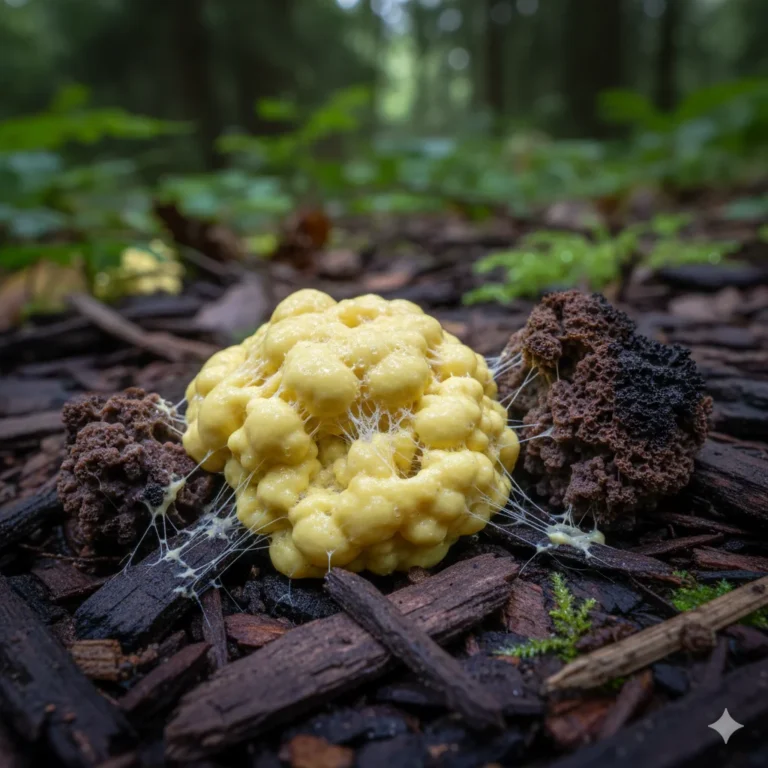
dog vomit fungus
Hey there, paw-rent! Grab a comfy seat and maybe a coffee. I want to talk about something I stumbled upon in my own backyard just last week. Picture this: I was letting my Golden Retriever, Barnaby, out for his morning zoomies. The sun was shining, the birds were chirping, and then… I saw it. A weird, yellow, foamy blob right on my favorite patch of mulch(dog vomit fungus in mulch). My first thought? “Oh, for the love of treats, what did Barnaby get into now?!”
But after a quick (and slightly grossed-out) investigation, I realized it wasn’t Barnaby’s doing at all. It was something far more fascinating! If you’ve ever had a moment like this, staring at a mysterious garden intruder, you’re in the right place. Let’s unravel the mystery of this gooey garden guest together, shall we?
What in the World is That Blob? Unraveling the Mystery of Dog Vomit Fungus (Slime Mold)
So, you’ve found a bizarre, yellowish, frothy blob that looks suspiciously like something your beloved pup might have, well, regurgitated. Your heart might do a little leap, a mix of disgust and worry bubbling up. What is that thing? Is it dangerous for your furry best friend? Should you panic?
Welcome to the perplexing world of “dog vomit fungus,” more accurately known as slime mold. This isn’t your everyday mushroom, and despite its rather unappetizing nickname, it’s actually one of nature’s most fascinating little curiosities. Think of me as your guide on this slightly icky but super interesting journey! We’re going to demystify this alien-looking blob, from its true identity to how to deal with it (spoiler alert: you might not need to do anything at all!).
related: Why Is My Dog Vomiting White Foam? Causes, treatment
What is dog vomit fungus (slime mold)?
Alright, let’s clear up the biggest mix-up first. While we all call it “dog vomit fungus,” it’s not actually a fungus at all! I know, mind blown, right? This was the biggest surprise for me, too. It’s a type of slime mold, which is a single-celled organism that’s kind of a weirdo in the best way—it behaves like an animal sometimes and a fungus other times, but it belongs to neither club. Think of it as nature’s own little shapeshifter!
The most common culprit behind the “dog vomit” appearance is Fuligo septica, which some folks cutely call the “scrambled egg slime” or, you guessed it, “dog vomit slime mold.” It’s an organism with a life cycle that’s straight out of a sci-fi movie, moving and feeding like a tiny amoeba before settling down to produce spores.
Is dog vomit fungus actually a fungus?
As we just sniffed out, the answer is a resounding “no!” This is a super common misconception, and it’s easy to see why. Its blob-like appearance can certainly look fungal. However, slime molds are classified as protists, a diverse group of organisms that aren’t animals, plants, or fungi. They’re the unique ones at the party!
Dr. Sarah Schmidt, a mycologist and plant pathology expert, clarifies, “Slime molds like Fuligo septica are fascinating because they challenge our traditional classifications. They don’t have cell walls made of chitin like true fungi do, and their feeding mechanism involves engulfing particles, much like an amoeba. The ‘fungus’ in its common name is purely descriptive of its appearance, not its biological classification.”
So, while we’ll keep using “dog vomit fungus” because it’s so paw-fectly descriptive, remember that its true identity is far more ancient and unique!
related: How to Induce Vomiting in Dogs Safely?
What does dog vomit fungus look like?
This is where the “dog vomit” name truly earns its stripes… or should I say, its spots? Imagine a glob of bright yellow, often foamy or spongy material that seems to appear out of nowhere overnight. It can range in color from a creamy white to a vibrant lemon yellow, sometimes even taking on an orange or reddish hue. As it gets older, it often dries out and changes its outfit, becoming more brittle and crumbly, eventually turning a brownish-black or dark gray.
The texture is also quite distinctive. In its early stages, it can be gooey and wet, almost like a viscous liquid. Later, it becomes more solidified, resembling a pile of scrambled eggs or, indeed, a rather unfortunate canine expulsion. It doesn’t have a defined shape and will often spread out over surfaces, conforming to the contours of whatever it’s growing on.
I remember that call from my neighbor, a fellow gardener, who was in a total panic, convinced her new puppy had been sick all over her prize-winning hostas. We both had a good laugh—and a sigh of relief—once we realized it was just Fuligo septica making its grand, gooey entrance!
Where is dog vomit fungus typically found?
Slime molds are nature’s ultimate recyclers, and they absolutely love damp, shaded environments where organic matter is abundant. You’ll most commonly spot dog vomit fungus in:
- Mulch beds: This is its absolute favorite haunt! The rich organic material and moisture retention of mulch create the perfect five-star buffet.
- Decaying wood: Old logs, wood chips, and even wooden garden borders are prime real estate for these blobs.
- Compost piles: Another hot spot for decomposition and moisture—it’s like a slime mold spa day in there!
- Grassy areas: While less common than in mulch, it can sometimes appear on lawns, especially if there’s a lot of thatch or decaying leaves.
- Under shrubs or dense foliage: Anywhere that stays consistently moist and out of direct sunlight is a potential slime mold hangout.
Essentially, if you have a spot in your garden that’s a bit shady and has plenty of decaying plant material, you’ve got a potential slime mold hotspot. It’s just part of having a healthy, active garden ecosystem!
What causes dog vomit fungus to grow?
Slime molds come out to play when a specific set of conditions are just right. Think of them as tiny, hungry organisms searching for their next snack. Here’s what gets the party started:
- Moisture: This is the key ingredient! After heavy rains, prolonged periods of damp weather, or if you’ve been a little too generous with the garden hose, you’re more likely to see it pop up.
- Warm temperatures: While they can appear in cooler weather, they really do their happy dance when temperatures are mild to warm, typically in late spring, summer, and early autumn.
- Organic matter: Their food source! Slime molds feed on bacteria, yeasts, and other microorganisms that are feasting on decaying organic materials. So, wood chips, mulch, dead leaves, and rotting logs are like a gourmet, all-you-can-eat buffet for them.
It’s not something that “infects” your garden; rather, it’s an opportunistic organism that shows up when the conditions are just right for its unique and fascinating life cycle.
How fast does dog vomit fungus grow?
This is one of its most surprising traits! Dog vomit fungus can appear seemingly overnight! It’s not uncommon to walk out one morning and find a sizable blob where there was nothing the day before. The plasmodium (the “feeding” stage of the slime mold) can move at a rate of several centimeters per hour, spreading across surfaces like a slow-motion wave. Once it decides to fruit and form the visible spore-producing structure, that process can also happen crazy fast.
“It’s not an aggressive growth in the sense of a plant quickly sending out shoots,” explains Dr. Arthur Billings, a soil biologist. “Rather, it’s a migration and aggregation of individual cells into a larger, visible mass, which can happen remarkably quickly under ideal conditions of warmth and moisture.” So one day it’s not there, and the next… hello, blob!
How long does dog vomit fungus last?
The visible “dog vomit” stage is usually a pretty short-lived performance. It typically lasts for a few days to a week. During this time, it will gradually dry out, change color, and become more brittle as it releases its spores into the world. Once it has completed its reproductive cycle, the visible mass will disintegrate and disappear, often leaving behind a little powdery residue.
However, just because the visible blob is gone doesn’t mean the slime mold is entirely absent. Its spores can lie dormant in the soil or organic matter, like tiny little seeds waiting for the next perfect, rainy day to reappear. Think of it like a persistent houseguest who leaves for a bit but always has a key to come back!
Does dog vomit fungus spread?
Yes, but not in the way a fungal disease might “spread” from plant to plant. The visible plasmodium can spread across surfaces as it grows and feeds. More importantly, once the “dog vomit” dries out, it releases countless microscopic spores. These spores are incredibly light and can be carried by the wind, splashed by water, hitch a ride on animals (maybe even on your pup’s fur!), or get moved around on gardening tools to other parts of your garden.
So, while it’s not “contagious” in a harmful sense, its reproductive mechanism is super effective at ensuring its widespread distribution, ready to pop up in new areas when the conditions are just right.
Safety Concerns
Now, for the big question on every dog parent’s mind: Is this weird blob dangerous for my fur-family?
Is dog vomit fungus harmful to humans?
Generally speaking, you can relax—dog vomit fungus is not considered harmful to us humans. There are no known toxins or pathogens associated with Fuligo septica that pose a threat to human health through casual contact or even if you accidentally inhale a spore or two.
However, like with any dusty substance, some individuals with severe allergies or respiratory sensitivities could potentially experience mild irritation if they were to inhale a large, concentrated cloud of spores, especially when the slime mold is dry and powdery. It’s always a good practice to avoid directly inhaling any airborne particles, just to be safe. A little common sense goes a long way!
“While generally benign, I always advise people to treat any unknown organism with a bit of caution, especially if they have respiratory issues,” recommends Dr. Emily Carter, an environmental health specialist. “Gloves are always a good idea if you’re directly handling it, not because it’s toxic, but simply as a hygienic gardening practice.” So, channel your inner gardener and pop on those gloves!
Is dog vomit fungus harmful to pets (dogs, cats, etc.)?
This is the million-dollar question, given its name! The good news that will let you breathe a sigh of relief is that dog vomit fungus is generally not considered toxic or harmful to our pets. Instances of pets eating it and becoming seriously ill are extremely, extremely rare.
However, our furry friends are curious, and if one were to decide this weird blob is a new snack and ingest a large quantity of the fresh, gooey stuff, it might lead to a bit of mild gastrointestinal upset, such as:
- Vomiting: I know, the irony!
- Diarrhea:
- A little lethargy:
These symptoms are usually temporary and mild, akin to your pup eating too much grass or getting into the trash—it just doesn’t agree with their stomach. The main concern would be if your pet has a known, very sensitive stomach or an underlying health condition.
What happens if a pet eats dog vomit fungus?
If you catch your pup mid-snack or suspect they’ve eaten some dog vomit fungus and they start showing any of the symptoms mentioned above, here’s what I’d recommend:
- Don’t panic! Take a deep breath. Most of the time, they’ll recover on their own without any intervention.
- Monitor them closely. Keep an eye on their energy levels and appetite.
- Contact your veterinarian. If symptoms seem severe, persist for more than a day, or you’re simply worried (we’ve all been there!), a quick call to your vet for advice is always the best move. They can offer reassurance or suggest the appropriate next steps.
From my experience chatting with countless pet owners, the most common “side effect” is simply the owner’s worry! The vast majority of pets walk away from a slime mold snack completely unaffected.
Is dog vomit fungus harmful to plants or lawns?
Again, the answer here is a tail-wagging no, dog vomit fungus is not harmful to plants or lawns. This might be the biggest relief for us garden-loving dog people! While it might look alarming as it spreads over the base of your plants or across your lawn, it does not feed on live plant tissue. Instead, it’s consuming the bacteria and fungi that are breaking down decaying organic matter around your plants.
It might temporarily smother very small seedlings or block a tiny bit of sunlight from the base of a plant if it grows very thickly over them, but this is rarely a significant issue for established plants. Your grass might look a little pale underneath it, but it will almost always bounce back once the slime mold packs up and leaves.
Think of it as a temporary, non-damaging visitor that’s just passing through, not a parasitic pest that’s here to cause trouble.
Management and Removal
So, you’ve identified the blob. Now what? Do you need to wage war on it, or can you just let it be? Let’s talk about your options.
how to get rid of dog vomit fungus?
If you decide you really can’t stand the look of it, or it’s in a spot your dog won’t leave alone, here are a few gentle methods to show it the door:
- Simply scoop it up: The easiest way! Use a shovel, trowel, or those gloved hands we talked about to scoop the slime mold into a bag. You can then dispose of it in your general waste.
- Spray with water: A strong, cheerful blast from your garden hose can often break up the slime mold and wash it away. This is particularly effective when it’s still in its gooey, fresh stage.
- Rake it out: If it’s decided to decorate your lawn, a good rake can help break it apart and distribute it, speeding up its drying process and helping it disappear faster.
- Let nature take its course: Often, the best and easiest course of action is simply to leave it alone. It’s a temporary visitor and will dry out and vanish on its own within a few days to a week.
I want to be very clear here: please avoid using harsh chemical fungicides or herbicides. Not only are they completely unnecessary for this harmless organism, but they can also harm the beneficial microorganisms in your soil (the good guys!) and potentially damage your plants. Let’s keep our gardens happy and healthy the natural way!
Should I remove dog vomit fungus?
This is entirely a personal preference, and there’s no wrong answer! From an ecological standpoint, there’s absolutely no need to remove it. It’s a natural part of the decomposition process and plays a small but important role in your garden’s ecosystem.
However, if its appearance bothers you aesthetically, or if you’re worried about your curious pup making it a chew toy (even if the risk is low), then by all means, remove it using the gentle methods above. My own approach? I usually just marvel at its weirdness for a day or two, maybe show it to Barnaby as a “look, don’t touch” lesson, and then might gently hose it down if it’s in a highly visible spot.
What are natural ways to remove dog vomit fungus & will vinegar kill dog vomit fungus?
The “natural ways” are essentially the gentle physical removal methods we just discussed: scooping, hosing, or raking. Since it’s not a harmful pathogen, there’s no need for elaborate “natural remedies” like vinegar sprays or homemade concoctions that might actually alter your soil pH or harm other garden inhabitants.
The most natural approach of all is simply to allow it to complete its funky life cycle and disappear on its own. It’s the ultimate in low-effort gardening!
Can I just leave dog vomit fungus alone?
Absolutely! This is often the top recommendation from gardening experts and biologists alike. Leaving it alone is perfectly safe for your plants, your pets, and yourself. It will naturally dry up, release its spores, and vanish within a week or so, leaving no lasting damage behind.
It’s a testament to the resilience and self-regulating nature of a healthy garden ecosystem. Sometimes, the best thing we can do as gardeners is to just let nature do its thing.
How can I prevent dog vomit fungus from growing?
While you can’t entirely prevent nature from doing its thing (and why would we want to?), you can make your garden a little less of a five-star resort for slime molds by:
- Improving drainage: If you have areas that consistently stay waterlogged, improving soil drainage can help.
- Managing moisture: Try not to overwater your garden. Water deeply but less frequently, allowing the surface to dry out between waterings.
- Turning mulch: Regularly turning your mulch beds with a rake or garden fork can help them dry out more evenly and break up the ideal, moist habitats slime molds love.
- Using different mulches: If you consistently get slime mold, consider trying a different type of mulch. Some gardeners find larger bark chips less prone to it than finely shredded hardwood mulch.
- Pruning for air circulation: Pruning dense shrubs or plants to improve air circulation can help those shaded areas dry out more quickly after rain or watering.
Remember, seeing a little bit of slime mold now and then is actually a sign of a healthy, active ecosystem in your soil! It means there’s plenty of organic matter being broken down, which is ultimately fantastic food for your plants.
Further Information
Ready to become a total slime mold nerd with me? Let’s dive a little deeper into the fascinating world of these quirky organisms!
Are there different types of slime molds that look like dog vomit fungus?
Oh, you bet! There are thousands of different species of slime molds, and it’s a wonderfully diverse and colorful group. While Fuligo septica is the most common cause of the classic “dog vomit” appearance, other species of slime molds can also appear as colorful, amorphous blobs.
Some other common genera you might spot on your garden adventures include:
- Physarum: Often forms delicate, net-like structures or brightly colored, smaller blobs. Some are truly beautiful!
- Stemonitis: This one looks like tiny, dark, fuzzy stalks, resembling a miniature, velvety forest.
- Didymium: Often forms white, powdery, or crust-like patches on wood and leaves.
While their appearances vary wildly, their general life cycle and love for damp, decaying organic matter remain consistent. The world of slime molds is incredibly diverse and visually stunning once you start looking closely!
What is the life cycle of dog vomit fungus?
The life cycle of Fuligo septica is truly a wonder of nature, resembling something out of a science fiction movie. It starts as individual, microscopic amoeba-like cells that live in the soil, quietly feeding on bacteria.
When conditions are right (think: plenty of food and moisture after a good rain), these individual cells get a signal to come together! They aggregate and fuse to form a single, giant, multinucleate cell called a plasmodium. This plasmodium is the “creeping” stage – a slimy, often brightly colored mass that can slowly move and spread, engulfing food particles as it goes. This is the stage right before it becomes the “dog vomit” blob we see.
Once the plasmodium has gathered enough nutrients and is ready to reproduce, it migrates to a drier, more exposed location and forms the characteristic “dog vomit” shape. This structure, called a sporangium, then ripens, dries out, and releases millions of tiny, dust-like spores into the wind.
These spores can lie dormant for years, waiting for the perfect conditions of moisture and warmth to germinate, releasing new amoeboid cells, and starting the incredible cycle all over again. It’s a remarkably efficient and ancient survival strategy!
If you’re interested in seeing this amazing process in action, I highly recommend looking up time-lapse videos of slime molds online – they are absolutely mesmerizing and will give you a whole new appreciation for this garden blob.
What is the scientific name for dog vomit fungus?
The scientific name for the most common “dog vomit fungus” is Fuligo septica.
- Genus: Fuligo (from the Latin word for “soot,” likely referring to its dark, powdery spore stage)
- Species: septica (from a Greek word meaning “decay,” a nod to its love for decaying matter)
Knowing its scientific name gives us a little more insight into its characteristics and preferred habitat. So, the next time you spot that mysterious yellow blob, you can confidently tell your friends and family, “Ah, that’s just Fuligo septica, doing its amazing, weird, and wonderful thing!”
Wrapping Up
So, there you have it, friend – the complete lowdown on that funky dog vomit fungus. What initially might seem like an alarming garden invader is actually a harmless, fascinating, and ancient organism just doing its job in the natural world.
It’s a happy little reminder that sometimes, the weirdest things in our gardens are also the most interesting. Often, the best course of action is simply to observe, appreciate, and let nature’s incredible diversity do its thing. So, go ahead, enjoy your garden and your pups – even with its occasional, gooey, yellow surprises! Now, if you’ll excuse me, Barnaby is giving me the “it’s time for my walk” eyes. Happy gardening
please leave comment
you may like it





sources
- https://www.thespruce.com/identifying-and-controlling-dog-vomit-fungus-2539510
- https://mastergardener.extension.wisc.edu/files/2015/12/DogVomitSlimeMold.pdf
- https://blogs.ifas.ufl.edu/sarasotaco/2020/06/09/be-at-home-with-nature-dog-vomit-slime-mold
- https://mdc.mo.gov/discover-nature/field-guide/dog-vomit-slime-mold-scrambled-egg-slime-mold
- https://gardenprofessors.com/barfslimemold
- https://mushroom-appreciation.com/dog-vomit-slime-mold-guide.html
- https://rutherford.ces.ncsu.edu/2024/06/dog-vomit-slime-mold-a-photo-journal
- https://en.wikipedia.org/wiki/Fuligo_septica
- https://www.petmd.com/dog/slideshows/mold-poisoning-pets-causes-symptoms-and-treatment

